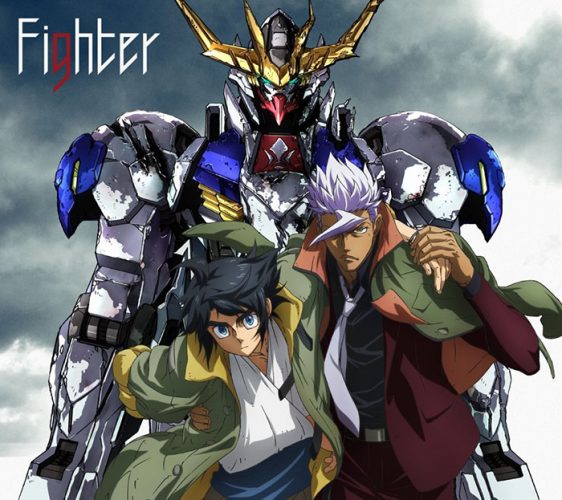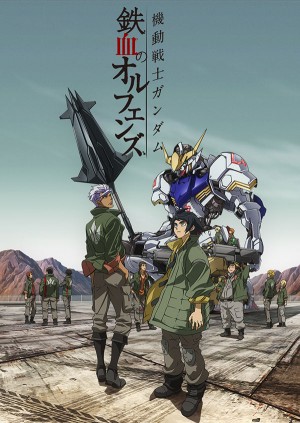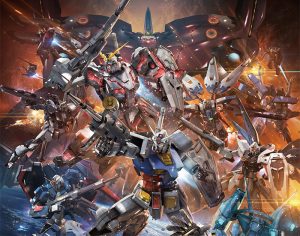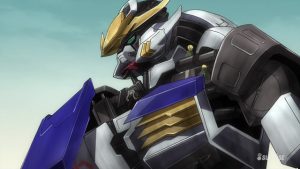- Episodes : 25
- Genre : Mecha, Sci-Fi, Military, Action, Space, Drama
- Airing Date : Oct 2, 2016 – Mar 2, 2017
- Studios : Sunrise
Contains Spoilers
Mobile Suit Gundam: Iron-Blooded Orphans Season 2 Introduction and Story (Spoilers)
Taking place sometime after the events of Iron-Blooded Orphans Season 1, Tekkadan has succeeded in bringing their first client, Kudelia Aina Bernstein to Earth’s parliament in order to help Mars’ economy but at the cost of numerous lives. This accomplishment has brought glory and honor to Tekkadan and they accept new recruits (usually children) from poor conditions. However, factions of Gjallarhorn, their arch nemesis, are rising to take revenge and reclaim their power. Thankfully, Tekkadan has their own ally within the organization, McGillis Fareed, but is he looking out for their interests? At times, McGillis seems very motivated by his own personal goals and only sees Tekkadan as his own personal pawns to become king.
Orga, the leader of Tekkadan has made it to the big time and now wears a suit as opposed to his own Tekkadan uniform from season 1 to reflect his change of status in society, but he hasn’t forgotten his true family. He still remembers his reasons for making Tekkadan, and that was to find a place where he and his comrades can belong, and feels he hasn’t achieved that goal. As for Mikazuki, the pilot of the Gundam Barbatos, his enemies now fear him as the Devil of Tekkadan. But due to the final battle in season 1, the right side of his body has become paralyzed but is at 100% whenever he is connected to the Gundam’s interface, the Alayna-Vijnana System.
What You Liked About Mobile Suit Gundam: Iron-Blooded Orphans Season 2
Since this is season 2, watching the first season is naturally a prerequisite. Without watching season 1, audiences will naturally be unable to follow (such as how Mika got his Gundam, how Tekkadan became famous, the relationships, and just about everything).
Even for fans that are familiar with mecha or Gundam as a whole, Iron-Blooded Orphans takes what has been done and delivers a fresh take on it. As discussed in previous Gundam Iron-Blooded Orphans related articles here on Honey, a good majority of the mech genre tends to use teenagers (and pre-teens) as their main characters and as the pilots of the mech. In most Gundam or any other mech titles, the mech pilot just happens to be an academic overachiever and/or is a genius with machines who gets their mech by accident. Or some of these pilots are just Gary Stus like Kira from Gundam SEED Destiny (also known as Jesus Kira).
As for Mikazuki, or Mika for short, and a good majority of the child soldiers of Tekkadan, they are in no ways scholarly. They are mostly illiterate and have never attended school. Due to the economic conditions on Mars, where Tekkadan is based, the only thing children can do is find work as child soldiers. The interesting thing about this is that the members of Tekkadan were not forced into it by a third party, but they’re there by circumstances and they are getting clothed, fed, sheltered and paid. The good news, Orga wants to help these children find suitable employment beyond the battlefield. The bad news, some of them die throughout the duration of the series.
Some of the initial episodes of the first act of season 2 centers around Takaki, a child soldier for Tekkadan, and how he has to deal with some rebels who as trying to assassinate the Prime Minister. Through these episodes, audiences learn about his dreams for the future beyond being a soldier, and how his friend Rustan wants to provide for his sister. These episodes show that the series is not just about Orga and Mika. For the main duo of Gundam Iron-Blooded Orphans, being soldiers is the only thing that makes them feel alive. They know that war leads to nothing, but it’s all they can do at the right price and yet find happiness with each other.
Discussion Time
This show is undeniably for mech fans and of the Gundam franchise. Fans probably love the design, the action, the unpredictable stories, the characters and their relationships. As for non-mech fans, this series is still recommended for its storytelling, characters, how it pushes the envelope, and superb voice acting. Unfortunately, we cannot comment on the dub due to watching the series exclusively in Japanese.
But if a series is going to have its ups, it’s going to have its downs. While most Gundam series tend to average around 45-50 episodes, this installment is only 25 and it does negatively affect it in a way it the format does with Gundam 00. Some things are unfortunately rushed and forced, and it lacks any core villains that get any development.
1. Great Acting

We strongly recommend the Japanese version for Kengo Kawanishi as Mika, and Yoshimasa Hosoya as Orga. Kengo Kawanishi has played numerous roles in Naruto but just owns the role of Mika. He excellently captures his blunt and stoic personality. Mika is straightforward as he is complex and Kawanishi does that by playing him in a rather neutral stance. Mika takes things the way they are but at the same time, he fights to win. Mika demonstrates qualities that are childlike and yet mature. On one hand, his experiences growing up as a soldier makes him adaptable but he doesn’t really understand regular social rules. Take him to a regular meeting where there are formalities and people like to beat around the bush, Mika just gets straight to the point and is really direct (without any awareness that sometimes being direct despite being honest can be considered impolite). Kawanishi just does a great job of performing all those complexities to Mika.
For Yoshimasa Hosoya, you may recognize him as Sekizan in All Out!! and as Daryun in Arslan Senki. The charisma of Sekizan and the parental nature of Daryun perfectly mesh together to make Orga. He is always in control and whenever there’s a problem, he’ll find a way to fix it despite needing a bit of time. He also shows he is very protective and caring of Tekkadan. Whenever his men are in jeopardy for trivial reasons or used as a decoy by a client, he is not afraid to come to their defense.
Last, one cannot deny the chemistry that Hosoya and Kawanishi share as Mika and Orga. The audience can feel their bond when they expose more vulnerable qualities when they’re alone together. They show they need each other in their own ways and this relationship wouldn’t be believable without their performances. As for the rest of the cast, it would take up too much of the rest of the review!
2. Amazing Design and Animation (Action)
「機動戦士ガンダム 鉄血のオルフェンズ」第25話『鉄華団』先行カット紹介です!クーデリアたちの危機にギリギリのタイミングで間に合った三日月&バルバトス。壮絶な戦いの幕が開く…。(制作P) #g_tekketsu pic.twitter.com/MvH78UVcvP
— 機動戦士ガンダム 鉄血のオルフェンズ (@g_tekketsu) March 25, 2016
Undeniably, most mech fans can’t enjoy a mech title without some action. While a good percentage of anime tend to rely on tactics, Mika as the pilot of Barbatos tends to be more brawn over brain, or in his case, balls over brain. To him, the best defense is a good offense. The code of Bushido or other classic warrior beliefs doesn't apply to him. It’s kill or be killed. Mika fights in a way that in most cases, he’ll never really panic. If something goes wrong, he somewhat brushes it off and persists. He doesn’t really re-think he just acts. The series does a great job of showing he’s not overpowered (which was a controversy with Kira in Gundam SEED Destiny) and just shows that his skills are an extension of him as a soldier as opposed to being a pilot thanks to its interface where the pilot and mech are one.
While the Gundam Barbatos’ design in the first season has a more gear oriented look (since it is considered a 300-year-old piece of equipment in the series), season 2’s design gives it a modern design (modern within the universe of Iron-Blooded Orphans) making it look a lot more majestic with more layers of armor and brighter colors. Not only does it progress in design, its performance is better than ever with improved mobility and firepower.
3. A Realistic Story that Pushes the Envelope (by present standards)
「機動戦士ガンダム 鉄血のオルフェンズ」第24話『未来の報酬』が本日20日17時よりMBS/TBS系列で放送です。放送直前先行カットその2です。あらためて今週もよろしくお願いします!(制作P) #g_tekketsu pic.twitter.com/C2yDVngmeT
— 機動戦士ガンダム 鉄血のオルフェンズ (@g_tekketsu) March 20, 2016
As stated, while previous Gundams such as AGE, Victory, and a bit of G Gundam have used children as pilots, Gundam Iron-Blooded Orphans takes it to a whole new level. When you see a child piloting a robot killing other robots, there is a sense of comfort to it. In a way, it’s comparable to an Internet troll getting away with his or her behavior because of the safety of being behind a keyboard without having to get punched in the face. Firing a gun from a mech isn’t 100% the same as firing a gun from your bare hands. With Iron-Blooded Orphans, the audience gets to see instances of children killing and getting killed by missiles and bullets without the protection of a mobile suit. In fact, older Gundams and mecha anime have portrayed these dark qualities in the past. With the Ideon movie, we see infants getting their heads blown off by bazookas. In Go-Lion, the Japanese version of Voltron, we see babies getting slaughtered.
The crazy thing about Iron-Blooded Orphans is that it enraged the Japanese equivalent of the Parents Television Council demanding an age limit to these shows with how they portray children as murderers. Does this mean that times are changing in Japan for the better, or for the worse? Does this go back to our previous Editorial Tuesday on political correctness and how it could consequently express artistic expression? We can’t really say for sure but the fact that televised anime has produced material more controversial than Iron-Blooded Orphans (and with Japan having one of the world’s lowest crime rates) should probably demonstrate that critics have nothing to worry about.
1. The Series Is Too Short
「機動戦士ガンダム 鉄血のオルフェンズ」第13話『葬送』が本日17時よりMBS/TBS系列で放送です!鉄華団&タービンズVSブルワーズの決着、そして…。今年最後の本放送、今週もよろしくお願いします!(制作P) #g_tekketsu pic.twitter.com/90GLwZu8mU
— 機動戦士ガンダム 鉄血のオルフェンズ (@g_tekketsu) December 26, 2015
If there is one issue with this series that some people may have with, is that this series is way too short and with everything that happens, the 25 episode format is not suitable for this installment, but for Gundam as a whole. It consequently affects many things, most notably its ending. It still excellently builds up but the event and aftermath just felt very forced. The first half of the last episode and the last half could have been very different episodes.
Another consequence of this format is it doesn’t allow the show to explore a good majority of its characters and its many groups. Episodes five through seven excellently demonstrates how the series can explore and develop its wide cast, and how they can contribute to the overall story. Unfortunately, the series length can make it difficult to keep track of who is who are all the numerous factions that come into play (though nowhere near the same severity as G-Reco). If both seasons may be averaged somewhere between 45-50 episodes, this could have been possible.
2. Teenage Parenting
本日はたくさん情報解禁しましたが、恒例のお題も発信します!【8/27のお題】目の前で女の子が2人も号泣!あなたならどうする?#鉄血の絆RT #g_tekketsu pic.twitter.com/Y3Nmvbx8w8
— 機動戦士ガンダム 鉄血のオルフェンズ (@g_tekketsu) August 27, 2016
In addition to its portrayal of violence, it briefly touches on the concept of teen parenting. With how the situation comes about in the series (because Atra and Mikazuki want a child), they openly confess their attempts in conceiving a child towards the climax of the series. Thankfully, the series does not show underage minors doing the deed but the idea of teenagers having children, especially for those audiences who reside in first world country may think this could push the envelope in comparison to the violence. The idea that the show confesses that two minors having consensual sex are likely to light numerous fuses (and Gundam SEED did this already).
The circumstances within the series that leads to this are that they’re at war and you never know what could happen so they just do it. Some audiences can buy into it while there are others who may find the notion ridiculous. The only reason to speculate why critics could be more riled up to teens having sex to have babies as opposed to killing people is because there is a more realistic chance of teens having sex as opposed to getting a gun and/or joining a private army.
3. Lack of Villains/Rivals
「機動戦士ガンダム 鉄血のオルフェンズ」第20話『相棒』先行カット紹介その6です!地球軌道上の戦闘でアインに命を救われたガエリオ。この表情が意味するものは…?(制作P) #g_tekketsu pic.twitter.com/Pz12YMIvpn
— 機動戦士ガンダム 鉄血のオルフェンズ (@g_tekketsu) February 19, 2016
In the history of Gundam, we have Char vs. Amuro, Heero vs. Zechs, Rau Le Creuset vs. Mu La Flaga, and so on. With a unique character like Mikazuki, he doesn’t have any definitive rivals though there are some that give him minimal trouble but not enough to give him a run for his money in a one-on-one battle in equal conditions. Though there is a masked character through Gaelio, he isn’t really utilized as a rival for Mikazuki. Though the character has his own motivations and it’s obvious to the audience that his identity as Gaelio, his unmasking lacks any true dramatic impact (despite some scars).
We can agree that you don't expect this series to be your run of the mill mecha series. The ending does a good job getting around this, but giving a rival to Mika would have been a good way of reflecting and exploring his distinct qualities.
Final Thoughts
Gundam is something that has been around for a long time and has been done over and over. What this series proves is not only is Gundam still popular, but fresh stories can still be made. If society or other parts of the world continue to face certain problems, the staff at Sunrise can find some way to tell stories that reflect that. The original Gundam was a great take on World War II. Zeta Gundam feels like a great critique on Vietnam. Gundam 00 shows how superpowers that have energy resources can be manipulative. With Iron-Blooded Orphans, we see a real take on child soldiers and yet still maintain their humanity.
But if you don’t care about the story and characters and only want to see the action, this series won’t disappoint you in any way. However, the main issue is the ideal episode count and 25 episodes just didn’t really feel enough to tell it as a whole. As for that, that can be a topic for Editorial Tuesday. So if this review has given you any inclination to check out Gundam Iron-Blooded Orphans Season 2, please so do. If you’ve already seen it, please share your thoughts in the comments.
Recommended Post
MSG: Iron Blooded Orphans - Fall 2016 & Winter 2017
Recommended Post
[Honey’s Crush Wednesday] 5 Mikazuki Augus Highlights - Mobile Suit Gundam: Iron-Blooded Orphans
Recommended Post
Top 10 Ultimate Gundam Protagonists
Recommended Post
Top 10 Gundam Mobile Suit in Gundam Anime Series [Updated]
Recommended Post
Top 10 Gundam Games [Best Recommendations]
Recommended Post






